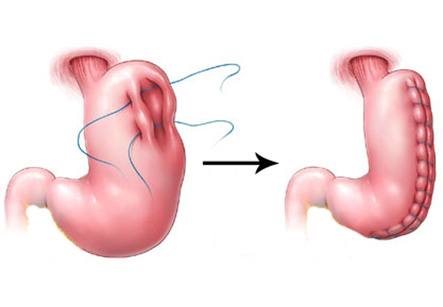Gastric Plication
Introduction
There are several types of surgical weight loss procedures, some procedures are designed to restrict the amount of food that can be eaten at one time (laparoscopic gastric bypass and laparoscopic sleeve gastrectomy), and some surgeries bypass the segments of the intestines to limit the absorption of calories such as Roux-en-y gastric bypass. Laparoscopic gastric plication is a restrictive procedure that reduces the size of the stomach and limits food intake, and it´s also referred to as Laparoscopic Greater Curvature Plication (LGCP).
The gastric plication procedure
Gastric plication is performed as a laparoscopic procedure. Five or six small incisions are made in the abdomen and the procedure is done using a video camera (laparoscope) and long instruments that are placed through these small incisions.
We have all the information you need about public and private clinics and hospitals that provide weight loss surgeries in Iran, Islamic Republic Of with the best quality and lowest possible prices

Patients can expect to lose 40% to 70% of their excess body weight in the first year after surgery.
This procedure involves sewing one or more large folds in the stomach wall. During laparoscopic gastric plication the stomach volume is reduced about 70%, which helps in reducing the capacity of the stomach and the patient eats less. Although it is similar to the vertical sleeve gastrectomy procedure, there is no cutting, stapling or removal of the any part of stomach or intestines during the procedure. Gastric plication has the advantage that it can potentially be reversed or converted to another procedure if needed.
This process reduces the volume of the stomach to the shape of a slender tube and keeps the natural stomach intact. However, to facilitate dramatic weight loss, the stomach is overlapped on itself, reducing the amount of food consumed. The latest advances in this type of plication surgery include total sleeve plication, gastric imbrication, and greater curvature plication. Like some other weight loss procedures, gastric plication is considered to be under research at this point.
The procedure is minimally invasive and it takes about one to two hours to complete. Most patients stay in the hospital 1 or 2 days to recover after surgery.
Weight loss by gastric plication
Gastric plication is essentially a restrictive procedure. It greatly reduces the size of the stomach and limits the amount of food that can be eaten at one time, and it does not cause decreased absorption of nutrients or bypass the intestines. After having just a small meal or snack, the patient will feel full very quickly and continue to feel full for several hours, decreasing appetite overall.
Some risks and considerations
There are some associated risks to this bariatric procedure:
1. Bleeding
2. Infection
3. Injury to other organs
4. Need to convert to an open procedure
5. Leak from the suture line used to plicate (“fold“) the stomach
Typical results of gastric plication
Depending on the pre-operative weight, patients can expect to lose 40% to 70% of their excess body weight in the first year after surgery. Many obesity related conditions such as diabetes, hypertension, sleep apnea and abnormal cholesterol levels improve or may even resolve after bariatric surgery.
Candidate for gastric plication?
Gastric Plication is usually considered an option if the patient´s BMI is over 27, and suffering from one or more significant co-morbid medical conditions, which are expected to be improved or resolved by weight loss. All the available bariatric procedures should be discussed with a gastric plication specialist and decide the best suitable procedure based on each individual patient´s metabolism and health. Gastric plication surgery (GPS) is becoming a popular alternative to gastric sleeve.
Benefits of the procedure
1. It is proven that the amount of weight that patients lose with GPS equals that of the vertical sleeve gastrectomy.
2. Most patients require staying only a few nights in hospital and patients usually enjoy their regular routines about a week after surgery.
3. Patients enjoy smaller amounts of food yet feel just as satisfied as having a complete meal.
4. GPS does not result in malabsorption, and the patient does not require a port or adjustments following surgery.
Most recent studies have indicated that gastric plication offers faster weight loss with fewer complications than other bariatric procedures, and the weight loss rates are found to be similar to those obtained via gastric bypass surgery.